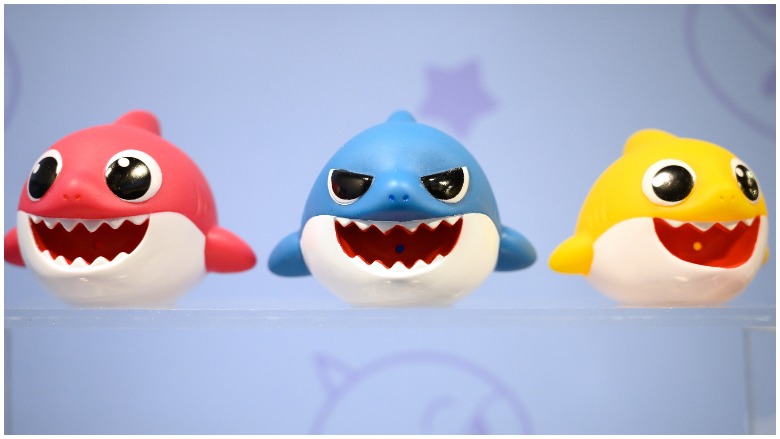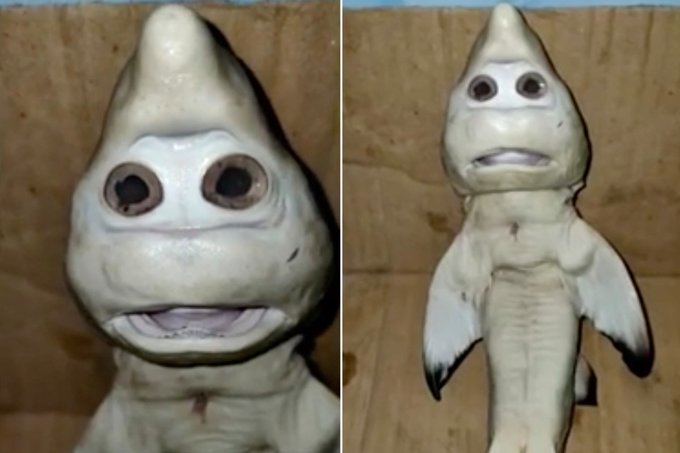
Getty A selection of "Baby Shark" toys at the annual "Toy Fair" at Olympia London on January 22, 2019.
An image of a baby shark bearing a startling resemblance to the popular children’s cartoon is attracting attention across the globe. A fisherman from Indonesia told local media outlets he collected the baby shark with the “human face” after accidentally catching an adult shark in his net.
Heavy reached out to marine biology experts at the University of Florida and the University of Miami to ask for professional opinions about the veracity of the photos. While it’s impossible to determine with 100% certainty whether the photos from Indonesia are real, the experts say it is possible for baby sharks to look like this. The shark in question may have suffered from a birth defect.
Heavy also reached out to biologists specializing in shark research at the National Oceanic and Atmospheric Administration. We have not yet heard back from them but will update this post once we do.
Here’s what you need to know:
The Fisherman Said Only 1 of the 3 Baby Sharks Had the Distinct Look
The Indonesian fisherman, Abdullah Nuren, told local media outlets he was fishing near Pepela Village in the East Nusa Tenggara province on February 20. According to translated versions of the local websites, Nuren said he inadvertently caught a pregnant shark in his trawler net. (According to Oceana, trawling involves dragging heavy nets across the ocean floor).
Nuren and his brother cut open the captured female shark and found three babies inside. Baby sharks are called pups, as explained by the Greater Cleveland Aquarium.
Nuren said he was “shocked” to discover that while two of the pups looked like their mother, the third “looks like a human face.” Nuren added that he has preserved the body of the baby shark for safekeeping. He said he has had offers from interested buyers but as of now, Nuren does not plan on selling it.
The Baby Shark’s ‘Eyes’ May Actually Be Nasal Cavities
The baby shark’s “eyes”, which appear to resemble the famous cartoon, are likely not eyes at all. Heavy heard back from Gavin Naylor, the director of the Florida Program for Shark Research at the University of Florida and curator of the Florida Museum of Natural History.
He responded that based on his professional opinion, the baby shark image appears to be legitimate. Naylor explained via email that “what might appear to be ‘eyes’ are the nasal capsules which have not completely closed over. If you were to roll the shark over you’d see the eyes placed dorsolaterally.” He noted that the shark’s real eyes would be much smaller than the nasal capsules.
Naylor also said the shark looks like it belongs to the Carcharhinidae family. According to the San Diego Natural History Museum, this type of fish, also called “requiem sharks,” can range in size from less than 40 inches to more than 24 feet. They are described as “torpedo-shaped and slender-bodied with rounded snouts.” The museum explains the shark feeds on other types of fish as well as marine mammals and birds.
The Baby Shark May Have Suffered From a Birth Defect Like ‘Partial Cyclopia’
The baby shark may have suffered from a birth defect. That was the opinion of Neil Hammerschlag, a research associate professor at the University of Miami’s Rosenstiel School of Marine & Atmospheric Science. According to his university profile, Hammerschlag’s research centers on the “behavioral ecology, conservation biology and movement ecology of marine predators, primarily focused on sharks.”
Hammerschlag told Heavy that while he cannot be sure whether the images from Indonesia are fake or real, a birth defect was possible. He said this “may be a case of partial cyclopia (two eyes but with one fused orbit).” Forbes has previously reported about a shark that looked like a cyclops, also found in Indonesian waters.
Naylor also said it was possible the shark was not yet fully developed. But he also told Heavy a birth defect was likely because of the size of the pup. “It is already quite large so it could also have been a developmental anomaly,” Naylor explained.
READ NEXT: Pennsylvania Teen Killed Disabled Sister in Her Bed, Cops Say

